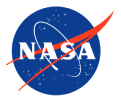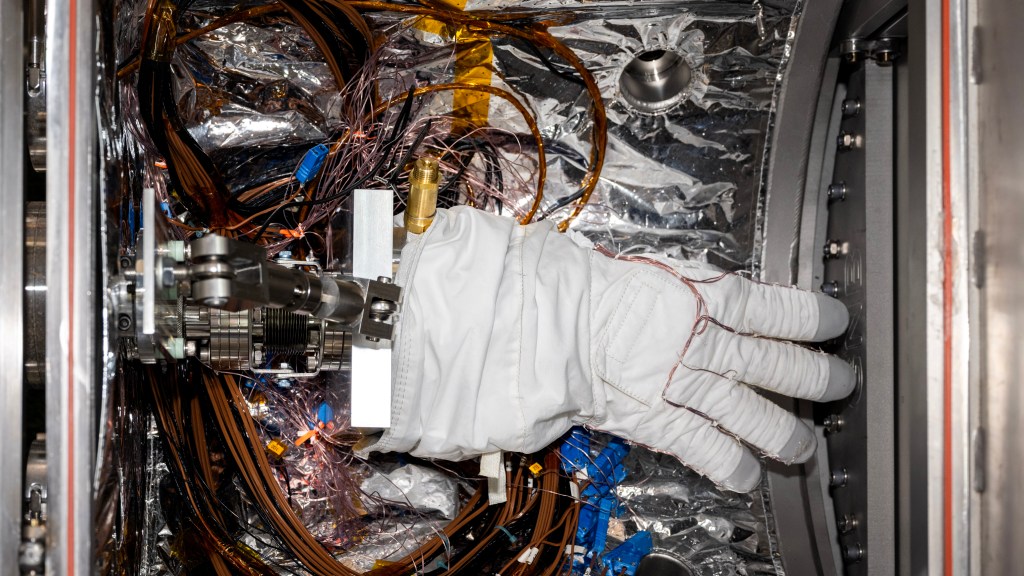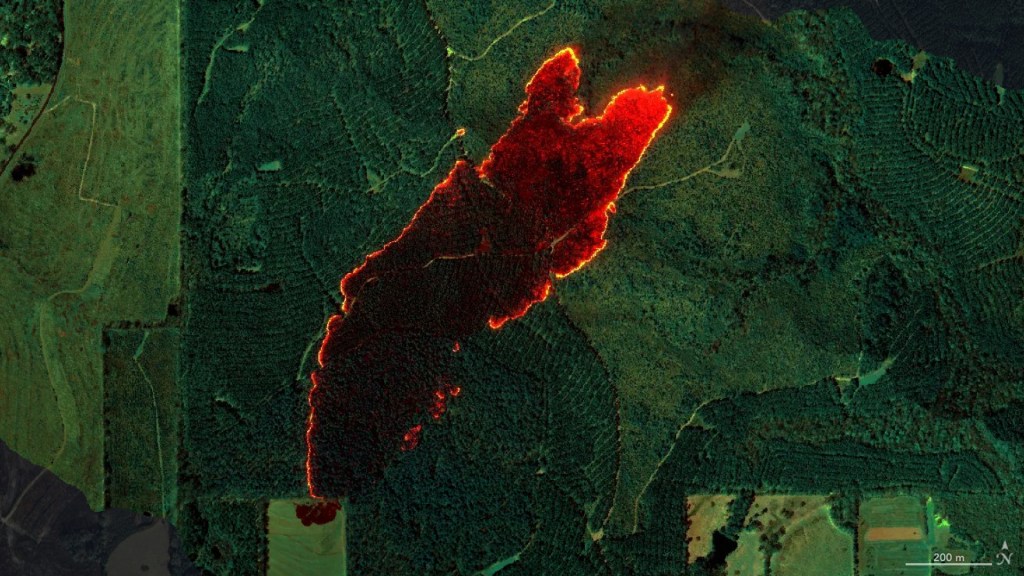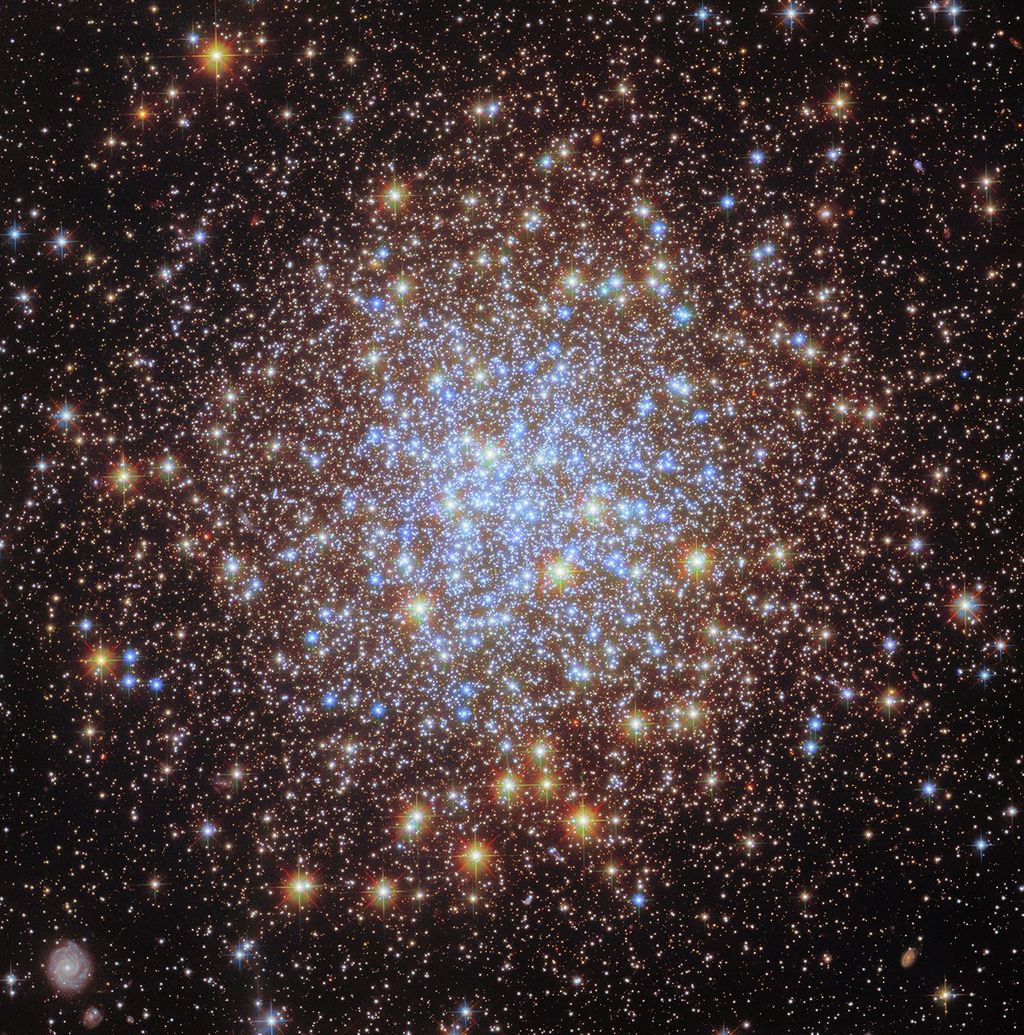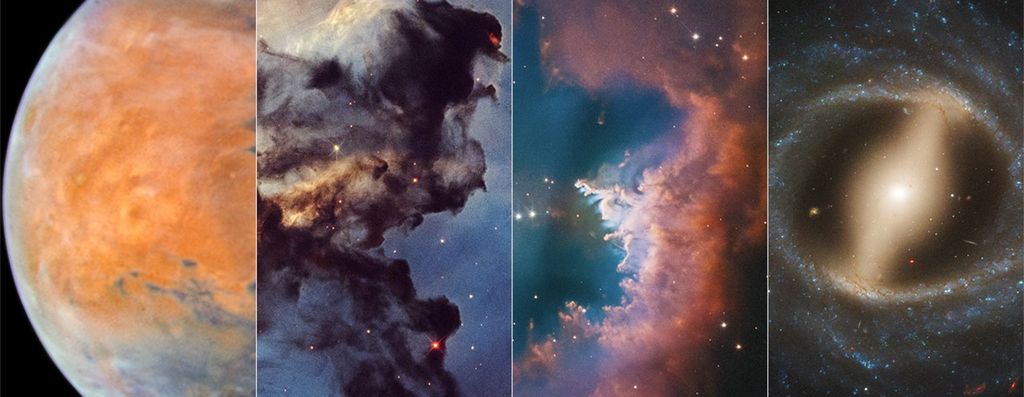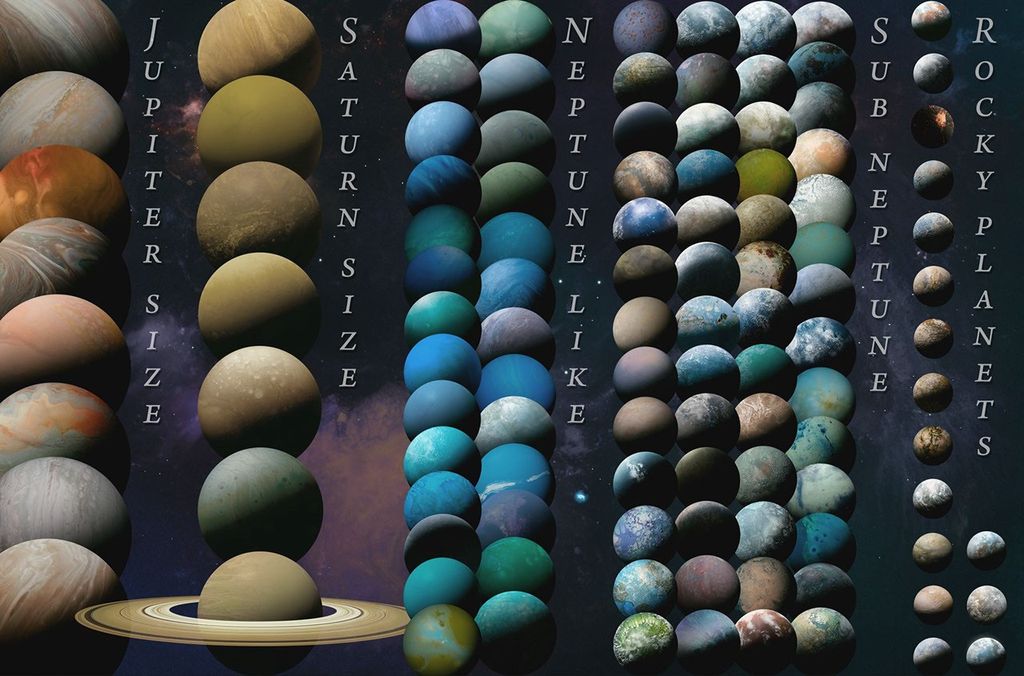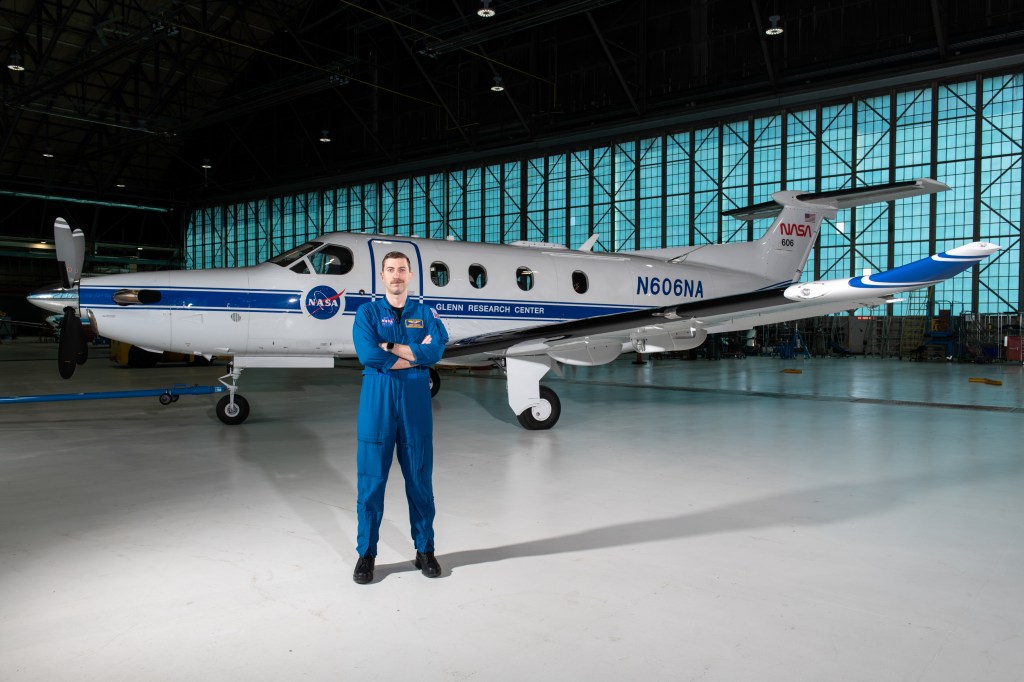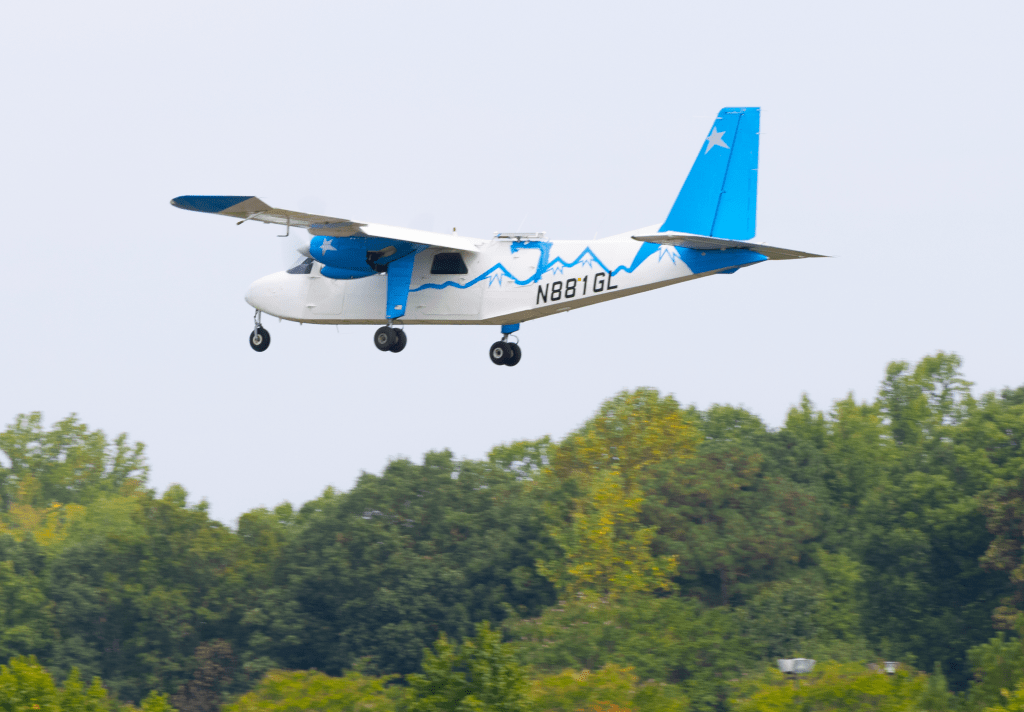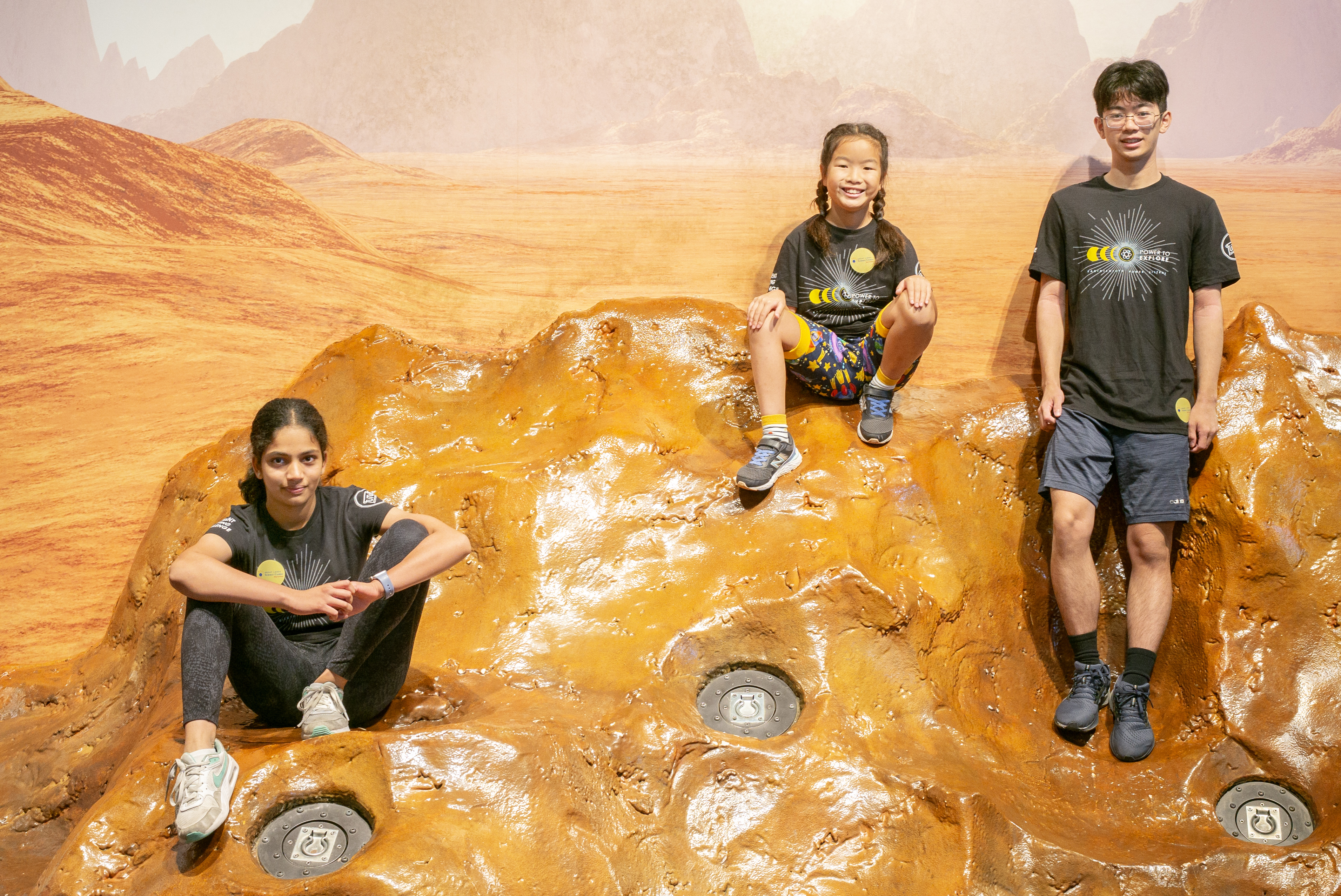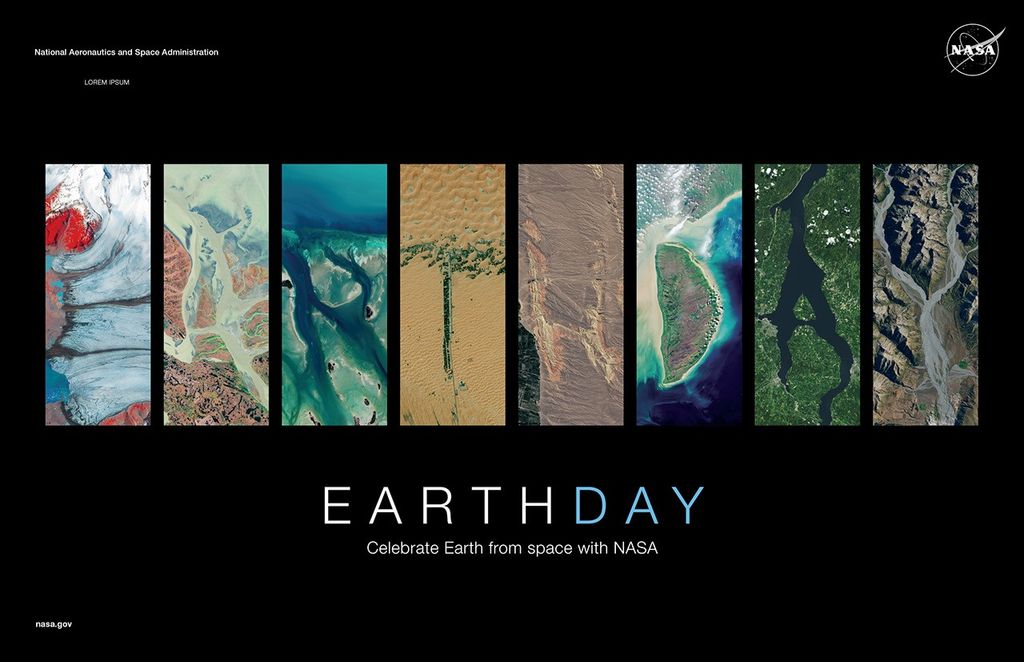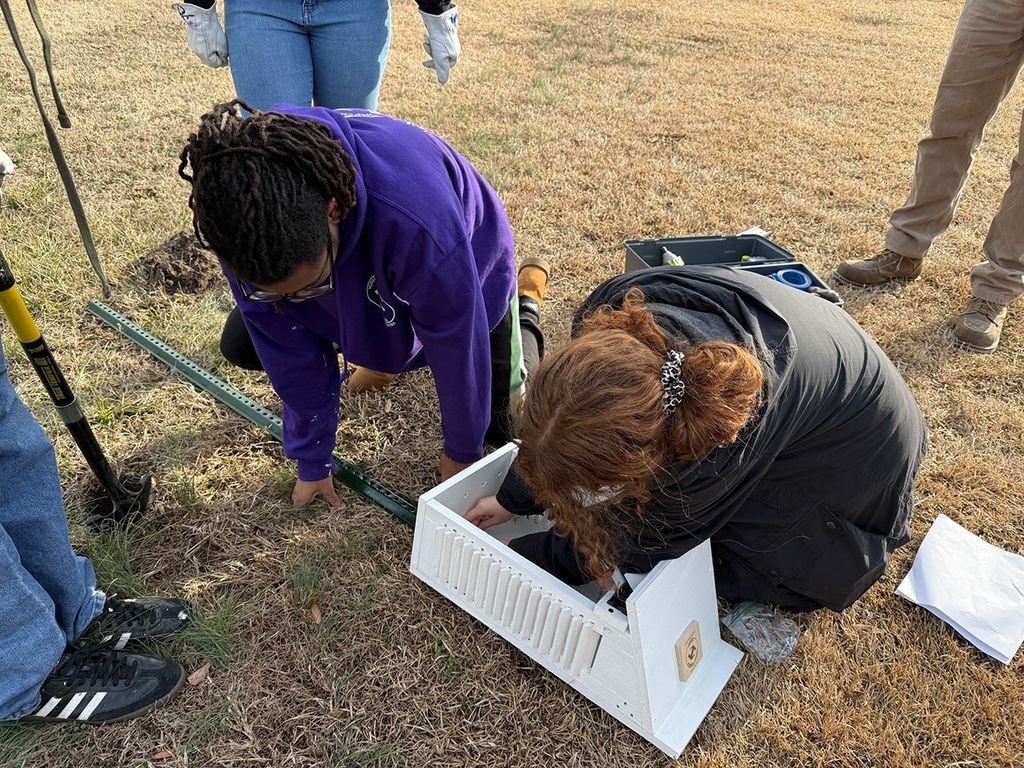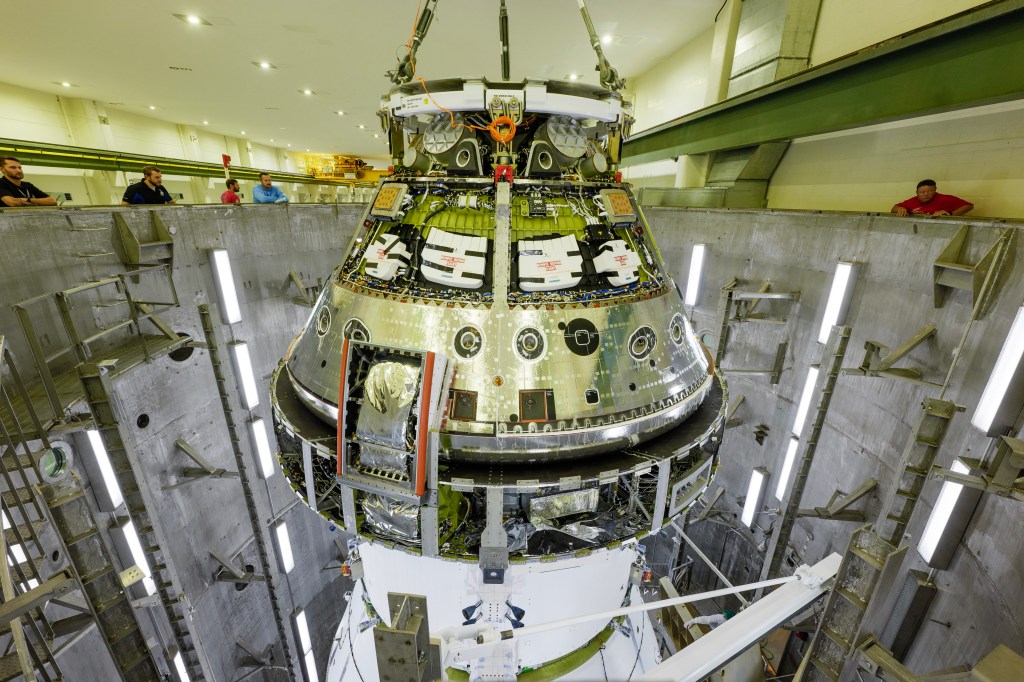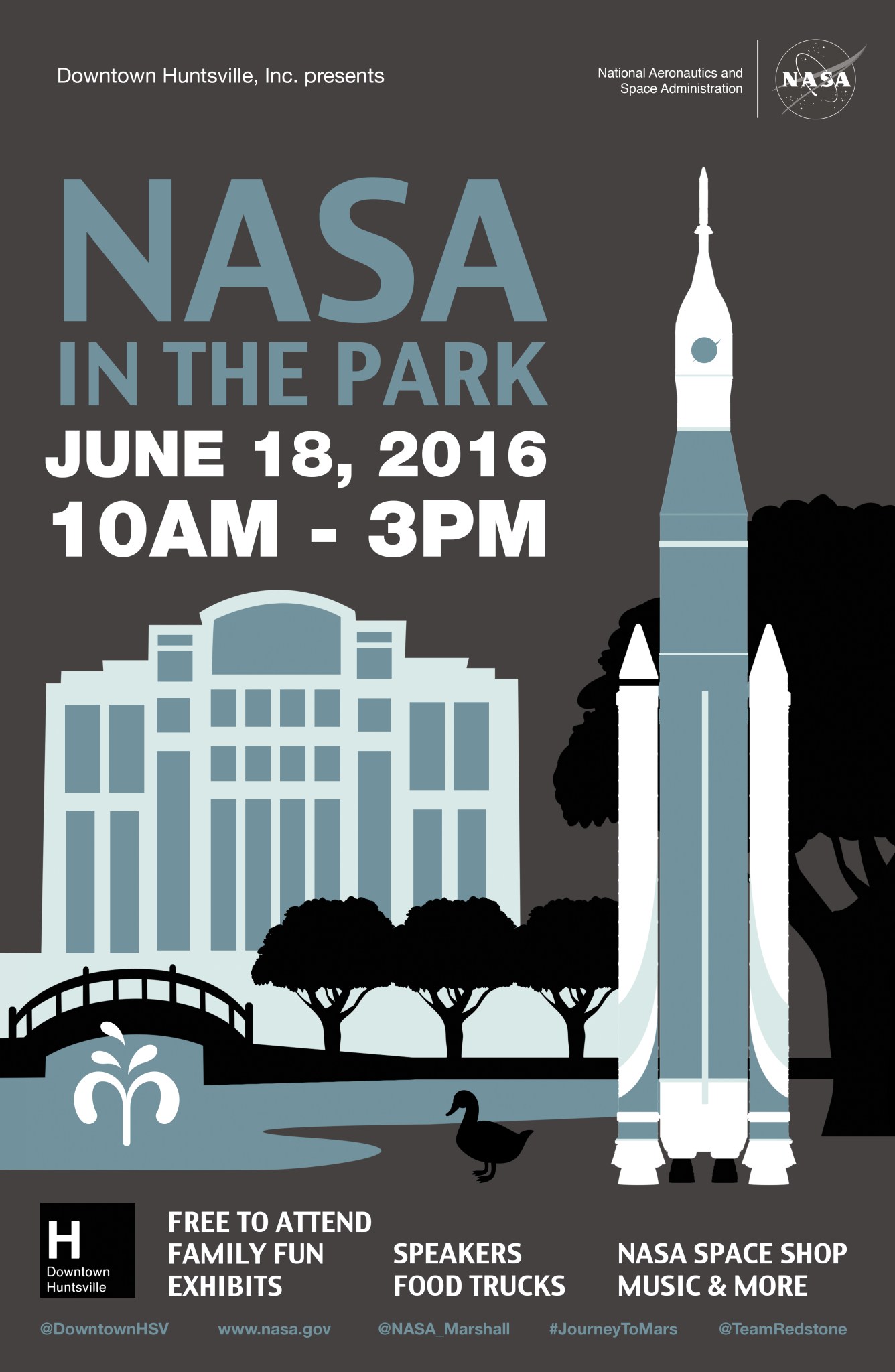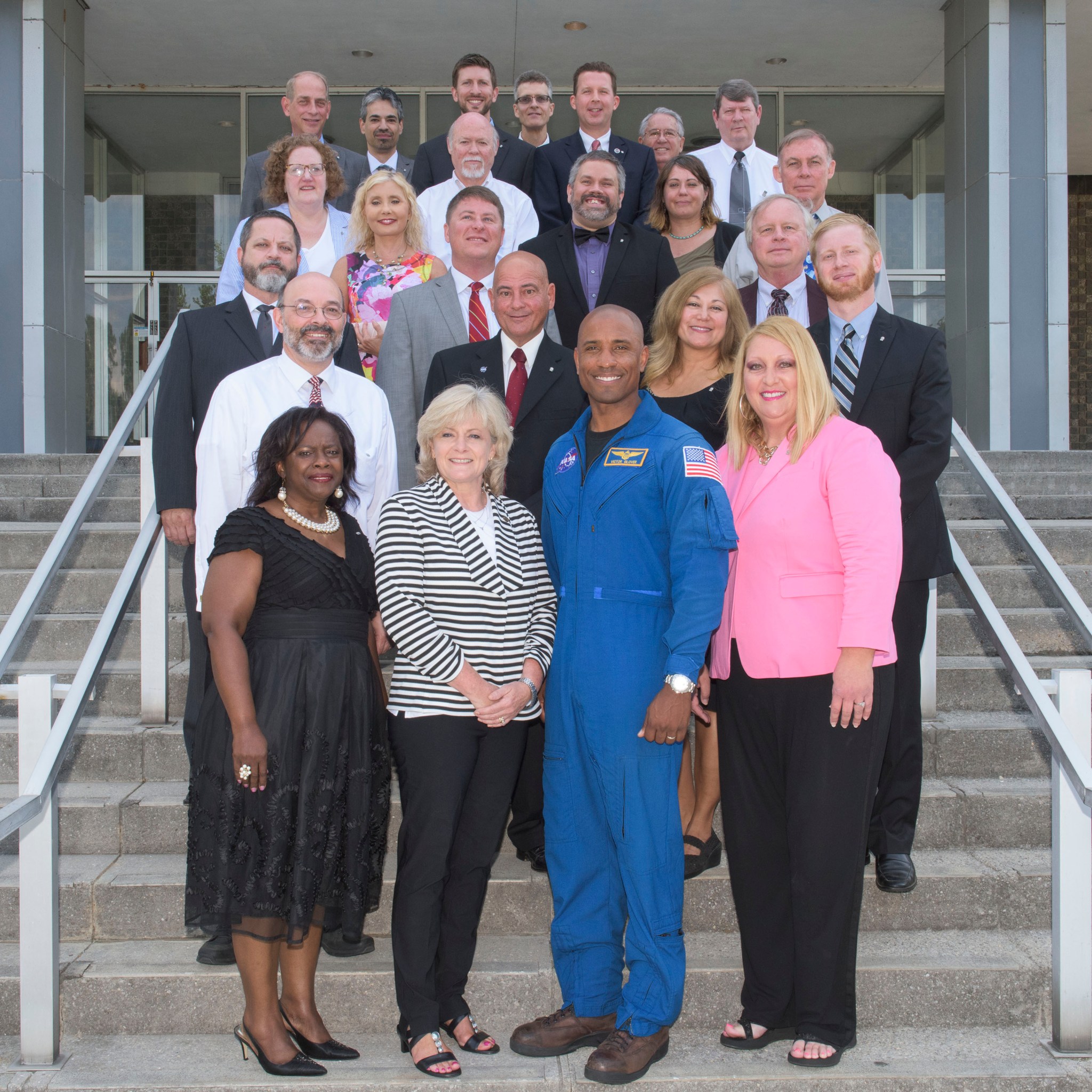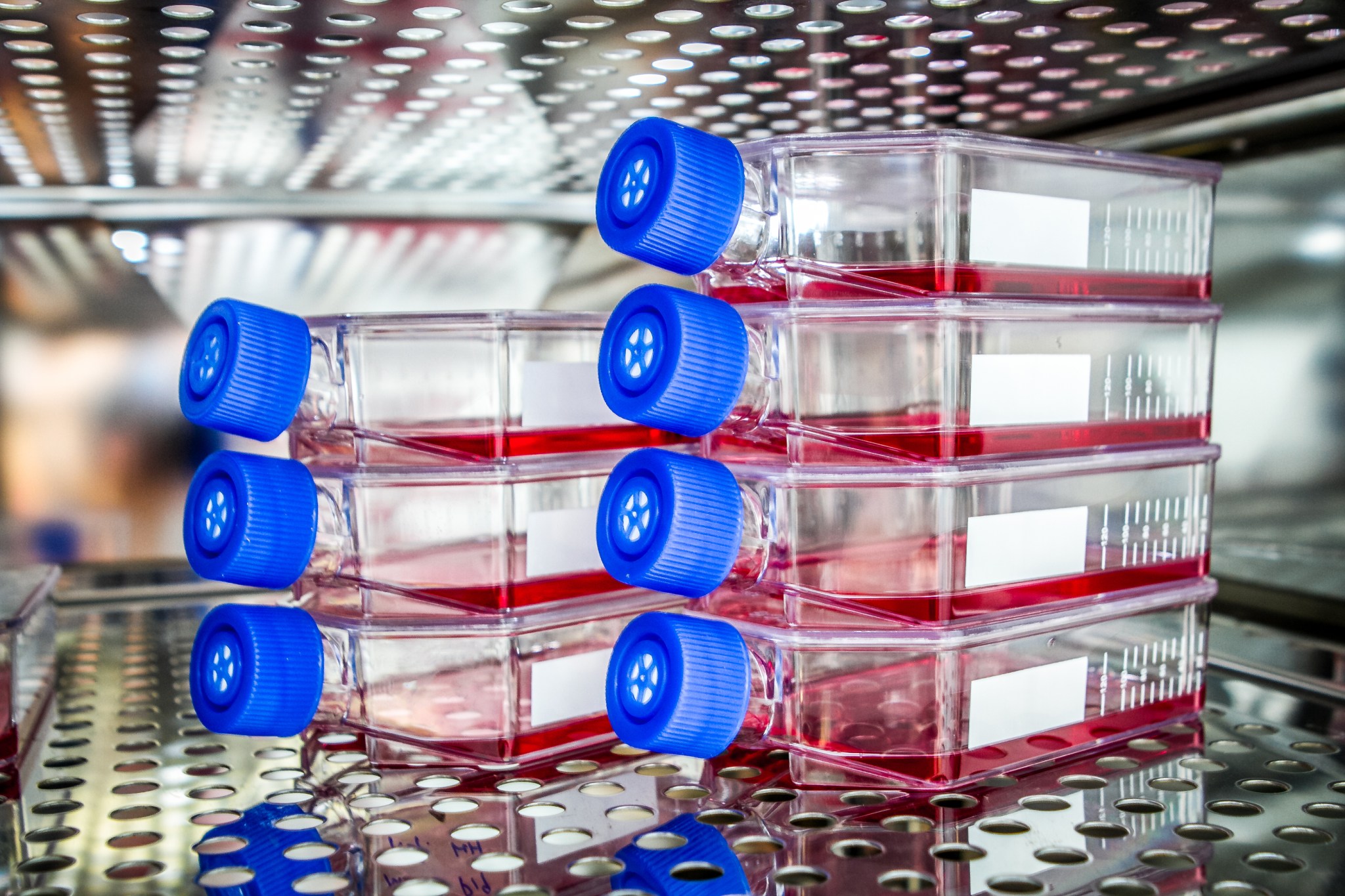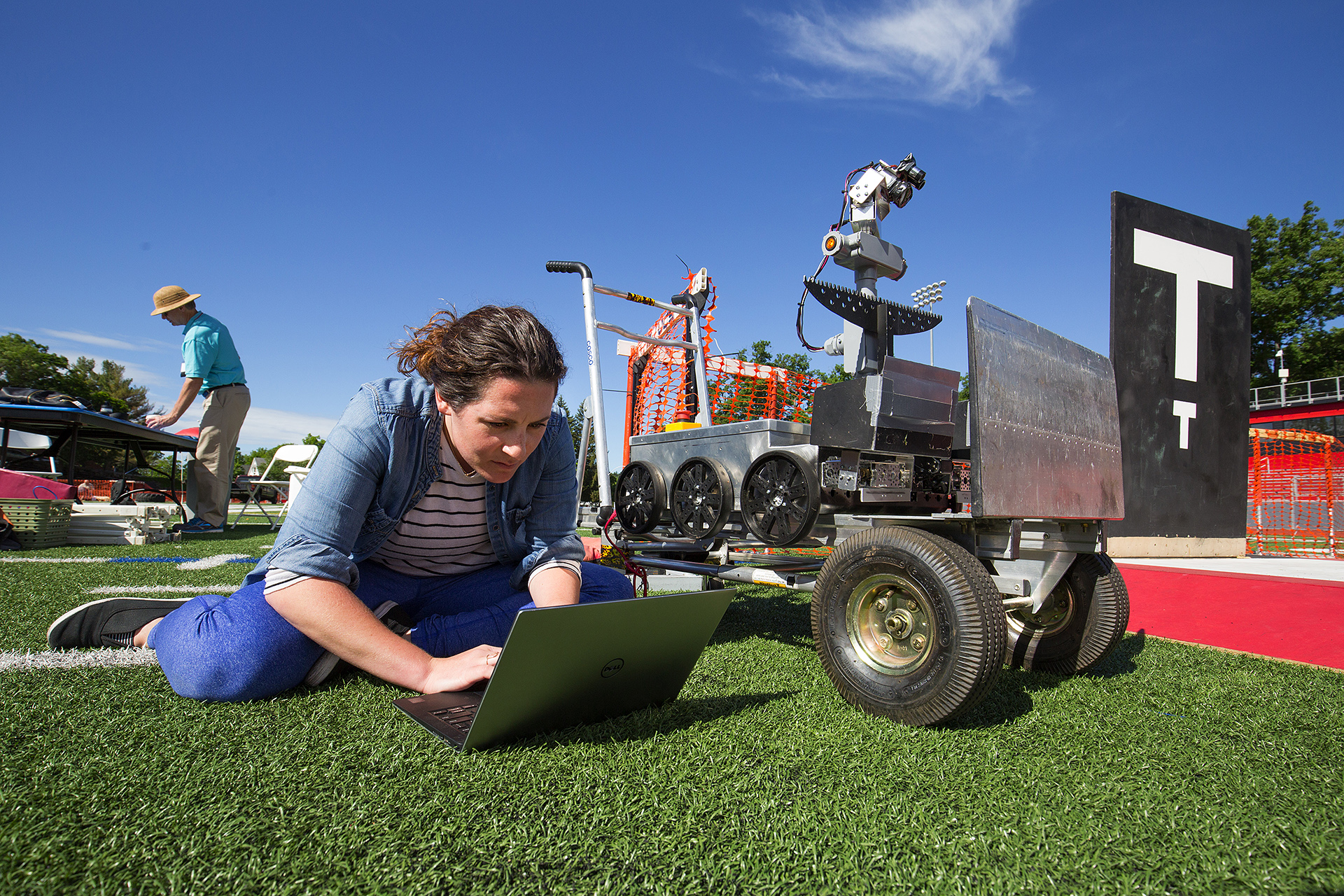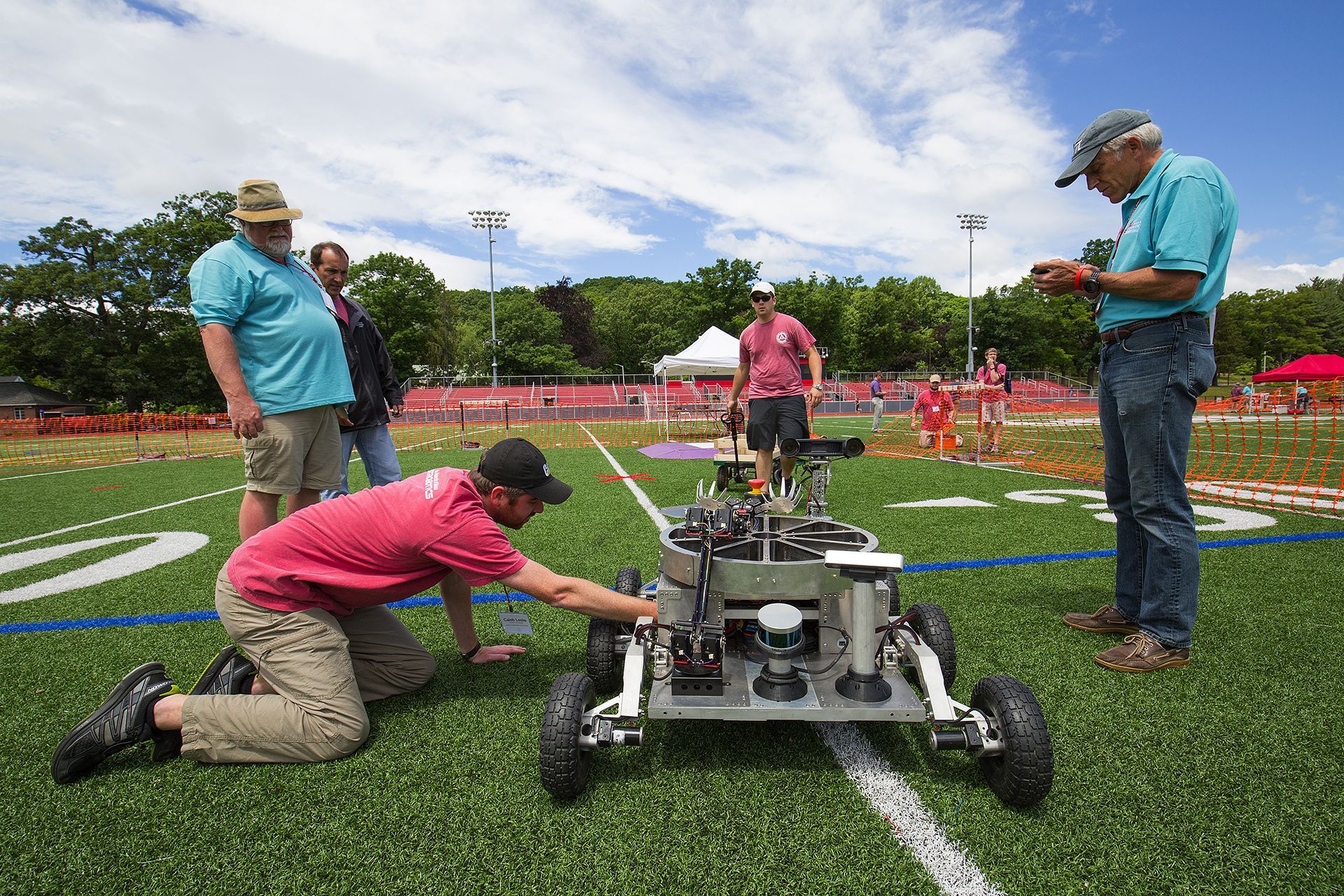In This Week’s Star
- Director’s Corner: NASA in the Park
- NASA Honors Marshall Team Members with Silver Snoopy Award
- SLS Booster ‘Chills Out’ Ahead of Super-Hot Ground Test
- NASA Completes Test Version of SLS Launch Vehicle Stage Adapter
- Faces of SLS: Justin Littell
- Marshall to Inspire Future Explorers During ‘Take Children to Work Day’ June 23
- New $500K NASA Challenge Aims to Grow Human Tissue to Benefit Deep Space Exploration
- Teams Awarded $5,000 Prizes in Level 1 of NASA’s Sample Return Robot Challenge, and Qualify for Shot at Bigger Award in Level 2
- The Great Exchange Summer Blast: Cool Event on Hot Day
- This Week in NASA History: Sally Ride Becomes First American Woman in Space — June 18, 1983
- Obituaries
Director’s Corner: NASA in the Park
Editor’s Note: In a new series, NASA Marshall Space Flight Center Director Todd May discusses work taking place at the center, the journey to Mars, challenges ahead and extends an invitation to this year’s NASA in the Park.
NASA in the Park, a celebration of the agency and community’s enduring relationship, will be held June 18 from 10 a.m. to 3 p.m. in Downtown Huntsville’s Big Spring Park East. The event, designed to share work being performed at Marshall with the community and inspire future generations of explorers, is free and open to everybody. Marshall team members are encouraged to attend.
We’re building a rocket that is going to put humans on Mars and become the cornerstone of deep space exploration in the 21st century. When the Space Launch System is ready for launch in 2018, it’s going to be a historic milestone for human spaceflight on our journey to Mars.
When you work at a place like Marshall, it’s easy to get lost in the mission — in the big picture — and forget that it’s the little things that can be the difference between success and failure. Without the talented men and women at Marshall, SLS is just an idea. But you’re making it real — you’re building it. You’re getting the message out about what we’re doing. You’re keeping us on budget and making sure our offices are running smoothly.
Regardless of what your role is at Marshall, success wholly depends on the sum of each and every person’s effort. You take care of the little things, so that NASA — this nation — can achieve the great things.
NASA in the Park is the perfect opportunity to celebrate your work and Marshall’s rich history of human space exploration and innovation with family, friends and neighbors. Marshall is an important part of the Tennessee Valley community and this is a great opportunity to showcase the work of the center and our partners. I’ll be there with Huntsville Mayor Tommy Battle to kick-off the event, and I hope to see you there.
With the upcoming Qualification Motor-2 test of the SLS boosters — a critical step toward moving the rocket closer to its first launch — it’s a great time to reflect on the tremendous value of the men and women of Marshall.
There are undoubtedly challenges ahead; tough decisions to be made. History shows that the people of Marshall will get the job done — from Apollo to the International Space Station to the Chandra X-ray Observatory your work has ensured that the greater mission transcends the inevitable political and legislative curveballs thrown our way.
So, let’s deliver what we’ve promised. Let’s make QM-2 a success and then pivot toward our next commitments, including SLS engine testing this fall. There is simply no better advocate for Marshall than progress itself.
Moving forward, here is my promise to you: The leadership team is going to do a better job keeping you informed about important issues that impact the work you’re doing and listening to what you have to say. All that I ask in return is that you continue to be tirelessly dedicated to the mission and the job you do in support of it.
Todd
NASA Honors Marshall Team Members with Silver Snoopy Award
On June 14, team members at NASA’s Marshall Space Flight Center were honored with the coveted Silver Snoopy award. The NASA astronaut corps presents the Silver Snoopy to outstanding civil-service and contractor employees who have significantly contributed to America’s human spaceflight program.
Marshall Deputy Director Jody Singer and NASA astronaut Victor Glover presented the awards to 22 Marshall team members during a ceremony in Morris Auditorium. For more information about the award, click here.
Honorees included Gloria Ayers, Office of the Chief Financial Officer; Don W. Carter, John M. Davis II, Robert Jeff Ding, Greg Dukeman, Frank L Hepburn, Marianne Huie, James McCarter, Andrew D. Mulder, Keith J. Parrish, Mike Staton, Carlos A. Velez, and Charles E. Wilkerson, Engineering Directorate; Joan G. Funk, James J. Lomas, Brian Matisak, Jo Weddendorf, Space Launch System Program Office; James Hill, Safety and Mission Assurance Directorate; David Hitt, Lori J. Meggs, and Michele R. Williamson, Office of Strategic Analysis and Communications; and Kristin L. Morgan, Science and Technology Office.
SLS Booster ‘Chills Out’ Ahead of Super-Hot Ground Test
By Megan Davidson
The Old Farmer’s Almanac is predicting a hotter-than-normal summer for Utah, but at Orbital ATK’s test facility in Promontory, crews are bundling up to chill down the booster for the world’s most powerful rocket, NASA’s Space Launch System.
The booster is being cooled to approximately 40 degrees Fahrenheit ahead of its second qualification ground test June 28. Testing at the thermal extremes experienced by the booster on the launch pad is important to understanding the effects of temperature on the performance of how the propellant burns. Data and analysis from past human-rated space programs have set the temperature limits for boosters between 40 and 90 degrees Fahrenheit. The booster was heated to 90 degrees Fahrenheit for the first successful booster qualification test in March 2015.
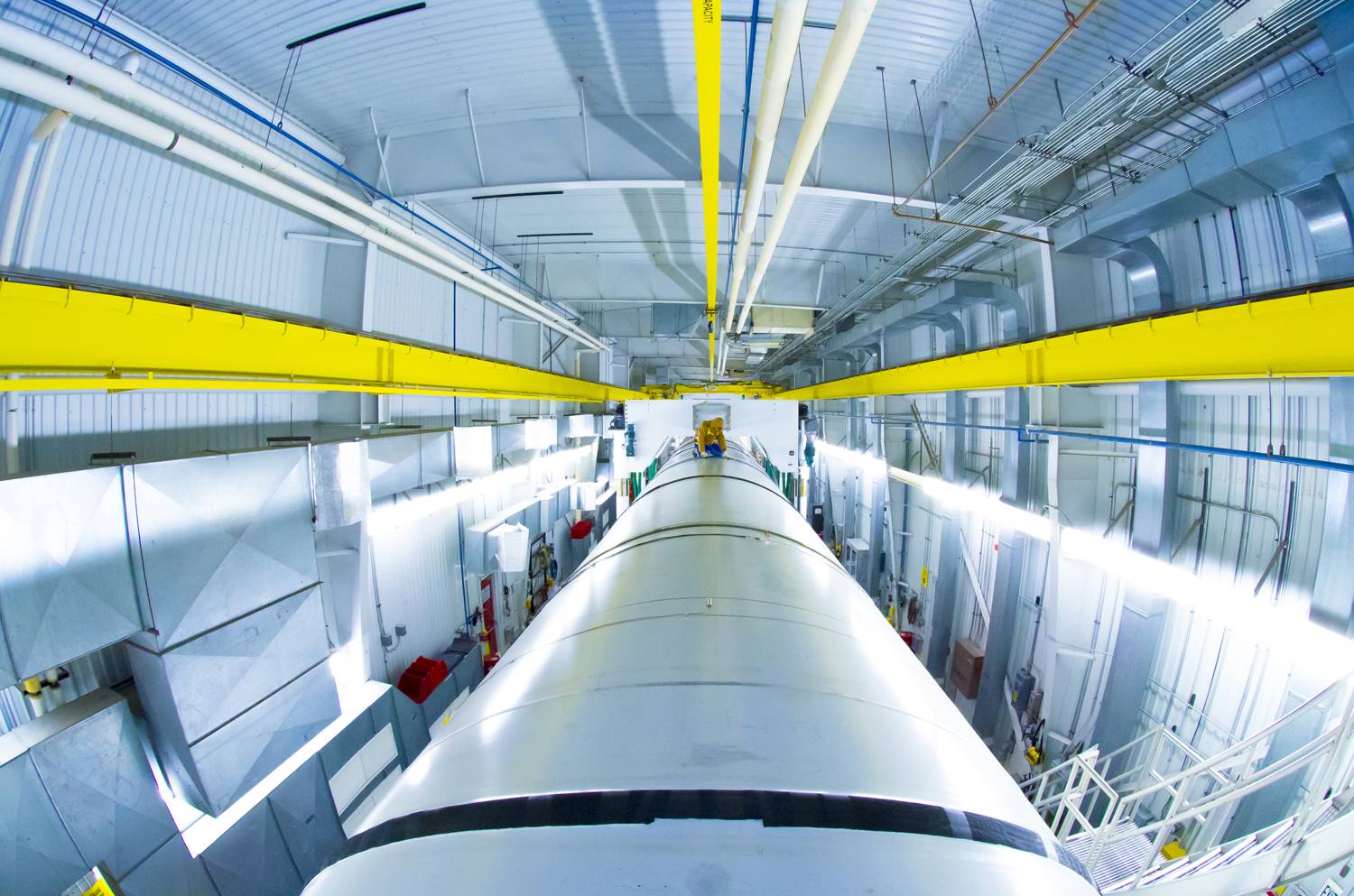
“In the winter or summer, you expect your car to start – regardless of what the temperature is outside,” said Mat Bevill, deputy chief engineer in the SLS Boosters Office at NASA’s Marshall Space Flight Center, where the SLS program is managed for the agency. “That car had to be tested to ensure it performed as it was designed to do, even in wide temperature ranges. That’s pretty much what we’re doing — except with a huge rocket booster.”
The massive size of the booster means it will take more than a month to reach the cold temperature target for the booster inside the test stand. Three large air-conditioning units – similar to those used for outdoor ice skating rinks – have been placed around the test facility, and are continually pumping air at 25 degrees Fahrenheit into the test stand house surrounding the booster. Sensors inside and outside the booster measure the propellant temperature, and analytical models predict the time it takes for the booster to be conditioned to 40 degrees.
“Propellant temperature shouldn’t be mistaken for the temperature of the booster when it’s fired,” Bevill added. “It may be conditioned to 40 degrees Fahrenheit, but once it fires, it is extremely hot – about 6,000 degrees Fahrenheit. That’s hot enough to boil steel.”
The day of the static fire, the test stand house will be rolled out of the way. “Cold conditioning in the summer isn’t exactly optimal, but that’s just one of the challenges with staying on schedule. We have to keep marching forward to be ready for flight,” Bevill said. “But just like it takes a long time to cool the booster, it also takes a long time for it to warm back up. Testing early in the morning before it gets too hot helps, and we chill to a few degrees cooler than the target of 40 degrees to account for the summer heat on test day.”
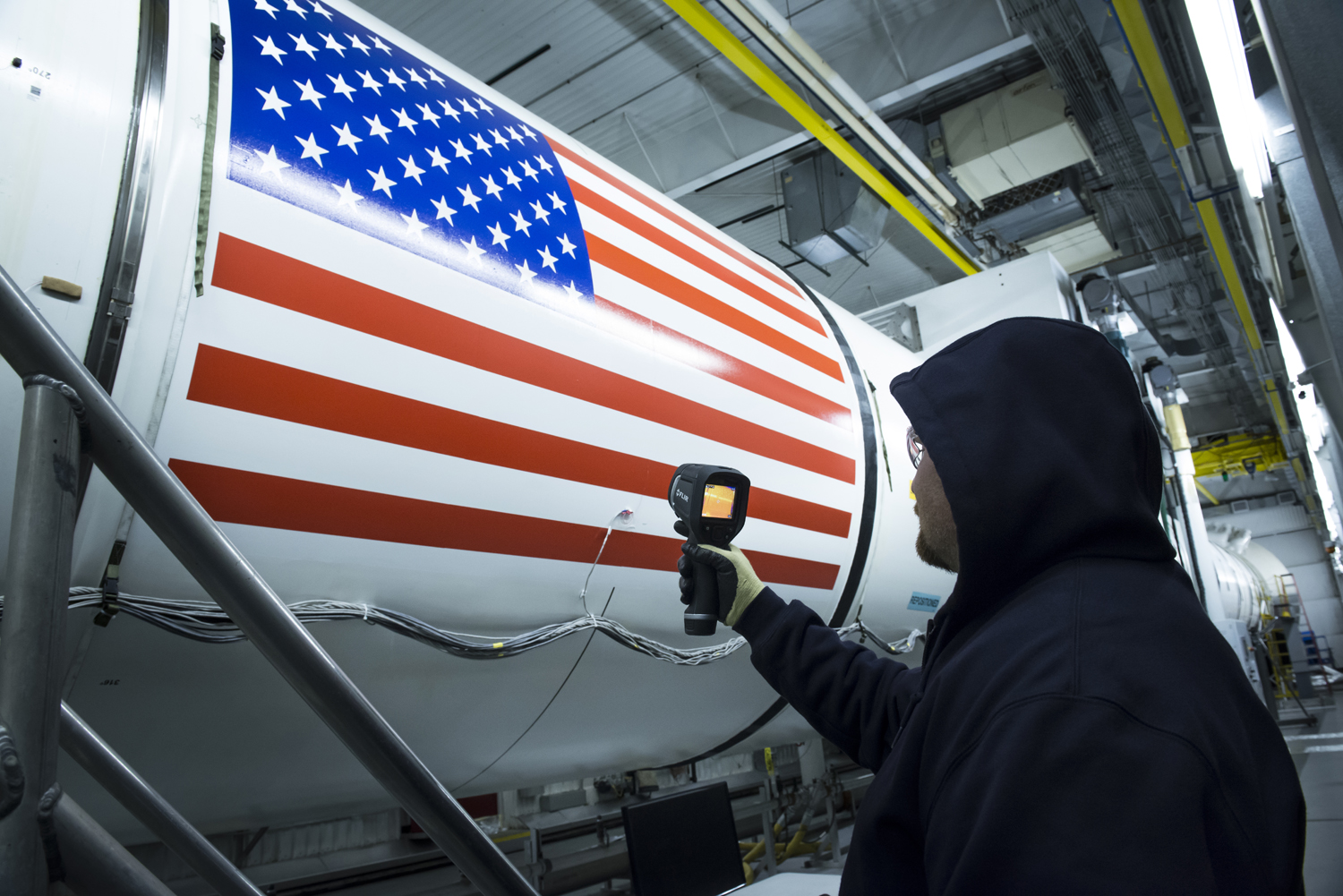
The two-minute, full-duration firing of the 177-foot booster will be the last full-scale test to support qualification of the hardware for the first two flights of SLS. Some 82 design objectives will be measured through more than 530 instrumentation channels on the booster. Along with measuring the ballistic performance at the lower end of the booster’s accepted propellant temperature range, the test also integrates SLS flight-like command and control for motor ignition and nozzle steering.
After this test, the next time a SLS booster will be fired up will be on the launch pad at NASA’s Kennedy Space Center. Two five-segment solid rocket boosters, along with four RS-25 engines, will propel SLS with the Orion spacecraft on its first mission in 2018.
“We’re working with Orbital ATK as they get ready to fire this booster in June,” said Bruce Tiller, deputy manager of the SLS Boosters Office at Marshall. “In conjunction with testing, booster flight hardware is currently in production. NASA is preparing for the first flight of SLS, and each of these programmatic milestones provide crucial data to enable human missions to deep-space destinations, including Mars.”
Davidson, an ASRC Federal/Analytical Services employee, supports the Office of Strategic Analysis & Communications.
NASA Completes Test Version of SLS Launch Vehicle Stage Adapter
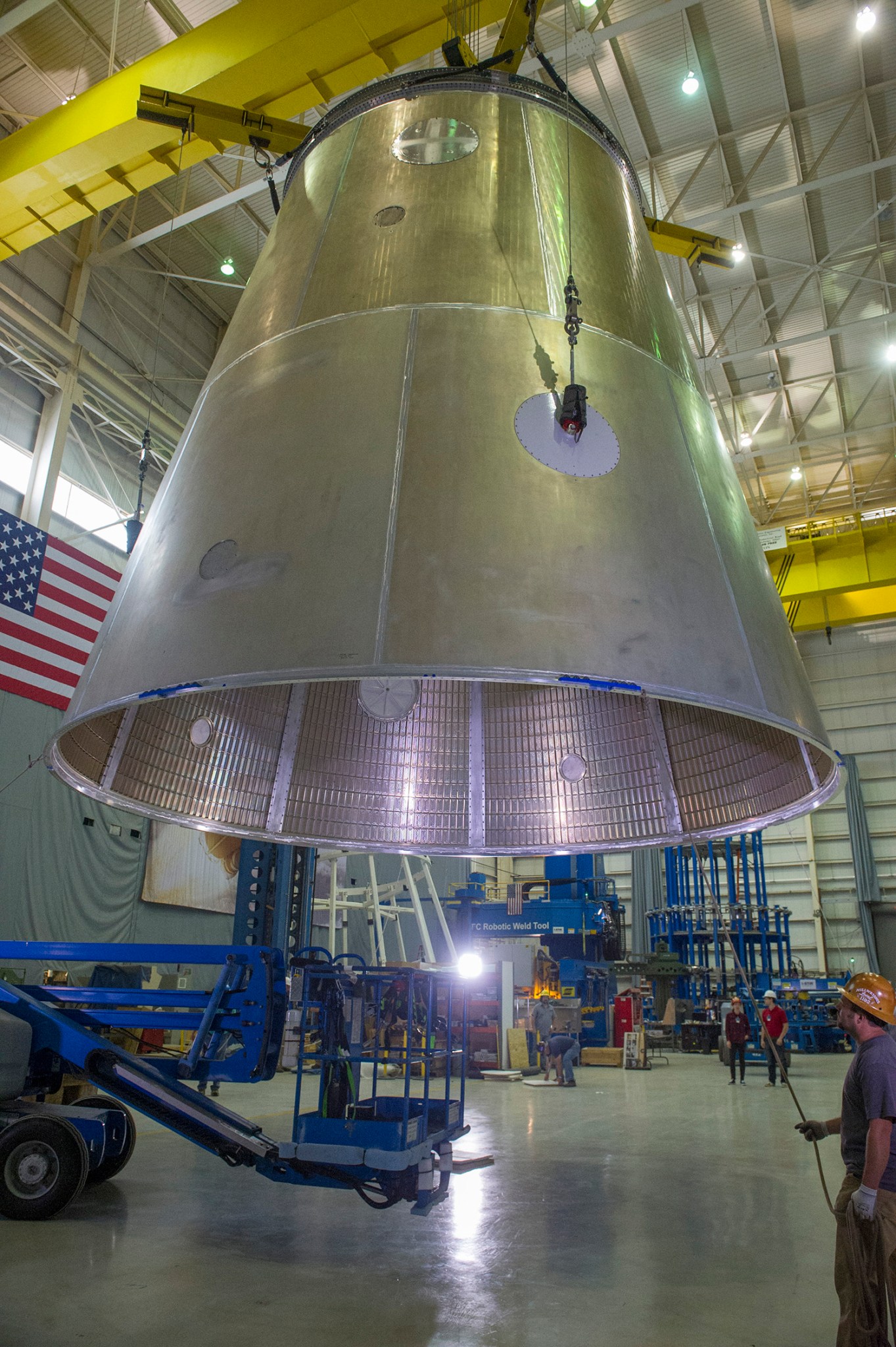
A crane lifts the structural test article of the launch vehicle stage adapter after final manufacturing on a 30-foot welding tool at NASA’s Marshall Space Flight Center. The LVSA will connect two major sections of the upper part of NASA’s Space Launch System — the core stage and the interim cryogenic propulsion stage — for the first flight of the rocket and the Orion spacecraft. SLS will be the world’s most powerful rocket and carry astronauts in NASA’s Orion spacecraft on deep-space missions, including the journey to Mars. Later this year at Marshall, the test version of the LVSA will be stacked with other structural test articles of the upper part of SLS. Engineers will examine test data and compare it to computer models to verify the integrity of the hardware and ensure it can withstand the forces it will experience during flight. The hardware’s cone shape is due to the ICPS having a smaller diameter than the rocket’s core stage. Teledyne Brown Engineering of Huntsville is the prime contractor for the LVSA. (NASA/MSFC/Emmett Given)
Faces of SLS: Justin Littell
This funny, first-time dad is building test and flight hardware for the world’s most powerful rocket, the Space Launch System. Get to know Justin Littell, a mechanical engineer in the Engineering Directorate at NASA’s Marshall Space Flight Center.
I am a mechanical engineer at NASA’s Marshall Space Flight Center, and I’m part of a team that just completed the structural test article for the Space Launch System launch vehicle stage adapter. That piece of hardware will connect the SLS core stage and the interim cryogenic propulsion stage. We built a test version to ensure it can withstand the forces it will experience during flight.
There’s a lot to my job, but basically, rockets are made up of a lot of pieces, and I figure out how to build some of those pieces. I also decide who needs to do what job to make those pieces come together as a rocket. I like to think of it as getting to play with Legos all day — just very large, complex Legos that travel at speeds of around 17,500 miles per hour.
One of the things I like most about my job is developing the tools and processes NASA needs to achieve the challenging objectives that come with building such a massive rocket. SLS is scheduled to fly no later than November 2018, and I look forward to seeing it launch. My work is built into this vehicle, and I want to see it succeed.
I’m originally from Dayton, Tennessee, and I got my engineering degree from the University of Tennessee at Chattanooga. I actually thought I would be an archaeologist, but I decided to follow in my older brother’s footsteps and go into the engineering field. Watching a lot of episodes of “MacGyver” may have had something to do with that decision, too.
I have always liked spending time outside, whether camping, hiking or kayaking. As a child, I would build traps for “bad men” and then forget where I built them. That made for some interesting nature hikes. All those activities take a backseat to sleep these days, as my wife and I just had our first child, Finley Kate. I hope my work at NASA makes Finley proud and will inspire her generation to explore Mars and other planets in our solar system.
Marshall to Inspire Future Explorers During ‘Take Children to Work Day’ June 23
By Rick Smith
NASA’s Marshall Space Flight Center will welcome children in grades 3-12 June 23, packing its annual “Take Our Children to Work Day” event with engaging activities, presentations and tours to pique the interest of possible future spacefarers, scientists and engineers.
Loucious Hires, director of Marshall’s Office of Diversity and Equal Opportunity, and Rhega Gordon, Marshall’s deputy chief financial officer, will welcome participating young people and their parents, grandparents or guardians at 8:15 a.m. in Activities Building 4316. A host of hands-on and participatory experiences then will await them across the Marshall campus, illustrating work done here in support of a variety of NASA missions and programs.
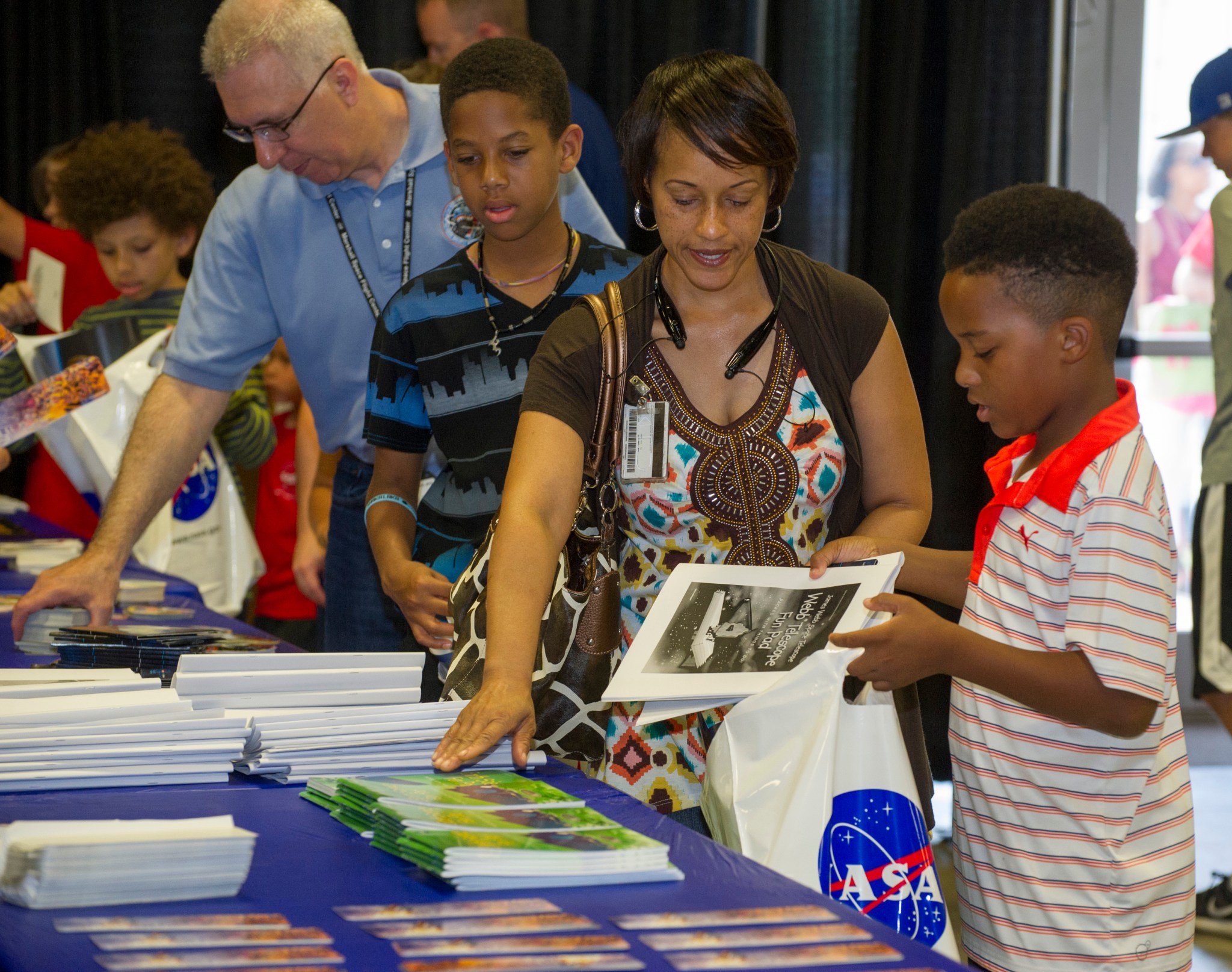
Among the highlights for this year’s event are the following special activities:
- Children can mingle with Marshall “rock stars” — scientists and engineers who work on various NASA projects and missions. One session for middle school students will be held from 8:30-10 a.m. A second for high school students will run from 10:30 a.m. to noon. Both sessions will be held in Building 4200, Room P110.
- Visitors to Marshall’s Payload Operations Integration Center in Building 4663 will see how NASA manages International Space Station science around the clock via three, 30-minute tours between 8:30-10:40 a.m. All participants must pre-register.
- Imagine pushing a 3,000-pound object with one hand while floating on air. Visitors can do just that in the Flight Dynamics Laboratory’s unique flat-floor facility in Building 4619. Half-hour tours run from 8:45-10:45 a.m. Pre-registration is required.
- Marshall engineer Richard Fischer will turn young people in grades 6-12 into robotics engineers, helping them build miniature robots using mint tins and toy motors. Two hour-long sessions will be held at 8:30 a.m. and 10 a.m. in Building 4200, conference room 715. Space and supplies are very limited, so pre-register early.
- Marshall Earth scientist Chris Schultz will host “Weather Ready Nation,” a program about dangerous weather close to home — lightning, tornados, flooding and high heat — and offer safety tips for protecting homes and families. Presentations will be at 8:30 a.m. and 10:30 a.m. in Building 4200, conference room 409.
- The day will close with a special viewing of the Disney/Pixar film “Inside Out” at 1 p.m. in Building 4316. Free popcorn and beverages will be provided.
Throughout the day, children can visit Building 4316 to make their own NASA-themed “space crafts” and obtain keepsake photos; take part in science demonstrations; and learn to drive robots during a simulated lunar expedition, as guided by Moulton Robotic Technologies, a team of robotics students from Moulton Middle School in Moulton, Alabama. They also can find out about Redstone Arsenal wildlife from Redstone Game Warden Kelly Smith, and learn fiscal responsibility with help from Redstone Federal Credit Union.
Two buses will loop continuously between locations, starting at 8 a.m. at Building 4200. Passengers at buildings 4201 and 4220 can board on the north side of Building 4203; those at Building 4601 can board on the south side of Building 4600. Drop-off and pick-up for Building 4316 will be on the south-facing front sidewalk of Building 4315. Buses are accessible by persons with disabilities. For other special accommodations, contact Abbie Johnson, assistant manager of the Office of Diversity and Equal Opportunity.
In addition to cafeteria and café services in buildings 4200, 4203 and 4663, the Marshall Exchange’s Food Truck Corral will be in operation on the corner of Martin Road and Rideout Road, featuring a variety of kid-friendly fare: burgers, hot dogs, chicken fingers, tacos, barbecue, grilled cheese and more, plus sides and desserts.
Team members are encouraged to visit ExplorNet for a complete agenda, and to register their children and sign up for specific activities.
Smith, an ASRC Federal/Analytical Services employee, supports the Office of Strategic Analysis & Communications.
New $500K NASA Challenge Aims to Grow Human Tissue to Benefit Deep Space Exploration
By Janet Sudnik
A new NASA Centennial Challenge could help mitigate negative effects of space travel on humans during long duration, deep space missions, and on Earth, aid pharmaceutical testing or disease modeling. The Vascular Tissue Challenge, announced and opened for registration June 13, offers a $500,000 prize to be divided among the first three teams that successfully create thick, metabolically functional, human vascularized organ tissue in a controlled laboratory environment.
NASA is partnering with the nonprofit Methuselah Foundation’s New Organ Alliance to run the challenge. New Organ is seeking ways to advance the field of bioengineering and accelerate new research and development in the field of organ transplants.
Related cells that are joined together are collectively referred to as tissue, and these cells work together as organs to accomplish specific functions in the human body. Blood vessels around the cells vascularize, providing nutrients to the tissue to keep it healthy. The vascularized, thick-tissue models resulting from this challenge will function as organ analogs, or models, that can be used to study deep space environmental effects, such as radiation, and to develop strategies to minimize the damage to healthy cells.
“The capability to vascularize tissues could enable new opportunities to benefit pharmaceutical testing and studying diseases,” said Monsi Roman, program manager for the Centennial Challenges Program, managed at NASA’s Marshall Space Flight Center. “We could also study environmental effects like radiation that will be a factor in deep space missions.”
Competitors must produce vascularized tissue that is more than .39 inches (1 centimeter) in thickness and maintains more than 85 percent survival of the required cells throughout a 30-day trial period. Teams must demonstrate three successful trials with at least a 75 percent success rate to win an award. In addition to the laboratory trials, teams also must submit a proposal that details how they would further advance some aspect of their research through a microgravity experiment that could be conducted in the U.S. National Laboratory on the International Space Station.
The Vascular Tissue Challenge prize purse is provided by NASA’s Centennial Challenges Program, part of NASA’s Space Technology Mission Directorate. Centennial Challenges is NASA’s citizen inventor prize program that invites the nation to help advance the technologies that will enable us to go to Mars and beyond, as well as improve life on Earth.
For information about the challenge, click here.
Sudnik, an ASRC Federal/Analytical Services employee, supports Marshall’s Office of Strategic Analysis & Communications.
Teams Awarded $5,000 Prizes in Level 1 of NASA’s Sample Return Robot Challenge, and Qualify for Shot at Bigger Award in Level 2
By Janet Sudnik
Five teams are taking home prize money and bragging rights after completing Level 1 of NASA’s Sample Return Robot Challenge, part of the agency’s Centennial Challenges prize program. The competition, in its fifth year, was hosted by Worcester Polytechnic Institute June 7-11 in Worcester, Massachusetts. Eighteen teams of citizen inventors, from universities to families to small businesses, competed in the challenge, which has a total prize purse of $1.5 million. Each winning team was awarded $5,000 for their success, and they have earned a shot at Level 2 of the competition, which will take place Sept. 2-5.
The winning Level 1 teams are:
- Team Al of Toronto, Canada (a new team to the competition)
- Alabama Astrorobotics of Tuscaloosa, Alabama (new team)
- MAXed Out of Santa Clara, California (returning team)
- Mind & Iron of Seattle, Washington (returning team)
- Sirius of South Hadley, Massachusetts (returning team)
“The teams have impressed us this year, and these are the best Level 1 results we have seen in the history of this competition,” said Monsi Roman, program manager of Centennial Challenges. “The intensity and commitment all of these competitors showed is a reflection of the relentless innovative spirit we hope to discover and enable through public challenges.”
The objective of the challenge is to encourage innovations in autonomous navigation and robotics technologies. Teams must design robots that can autonomously locate, collect and return samples to the starting point. For Level 1, each robot had to return two known samples within 30 minutes without human control or the aid of Earth-based technologies, such as GPS.
This stage was a precursor to the more difficult requirements they will face in Level 2, where they must locate up to 10 unknown samples that vary in size, shape and difficulty. The samples, classified as easy, intermediate and hard, are assigned corresponding point values.
These five winners will join two teams that qualified for Level 2 in prior competitions: Survey of Los Angeles, California, and the West Virginia University Mountaineers of Morgantown. All teams will have a two-hour limit at this level, and have the opportunity to win all or a share of the remaining $1.36 million.
Roman and WPI President Laurie Leshin, who previously served as a senior leader in NASA’s science and human spaceflight programs, presented awards to the team members June 11 at TouchTomorrow, an annual science and robotics technology festival at WPI. All of the teams showcased their robots to the public at the event, which also featured NASA and WPI exhibits in science, robotics and space technology.
The Centennial Challenges program is part of NASA’s Space Technology Mission Directorate, which is innovating, developing, testing and flying hardware for use in NASA’s future missions. It is managed at NASA’s Marshall Space Flight Center.
For more information about the competition, click here.
Sudnik, an ASRC Federal/Analytical Services employee, supports Marshall’s Office of Strategic Analysis & Communications.
The Great Exchange Summer Blast: Cool Event on Hot Day
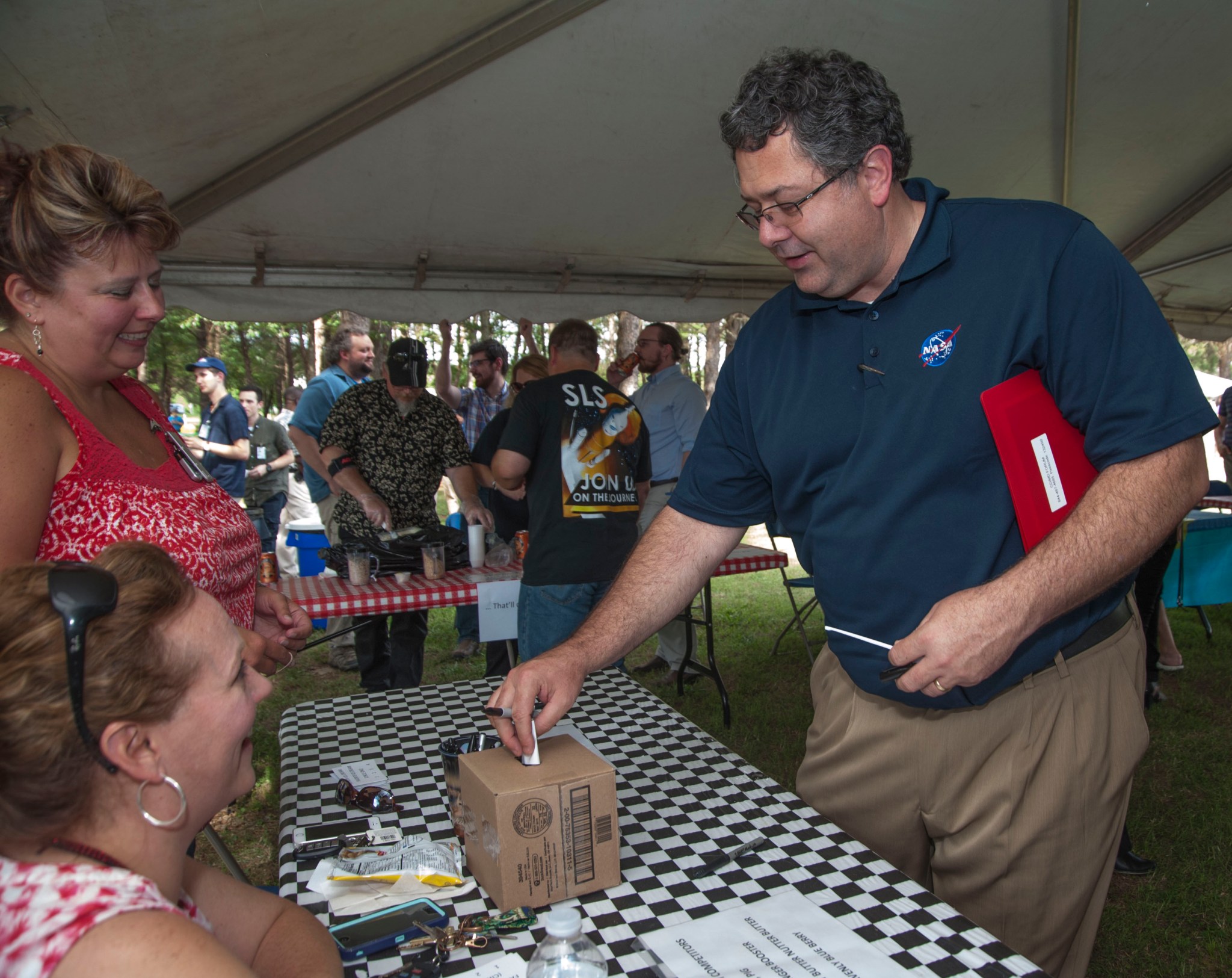
Marshall Space Flight Center Director Todd May casts his ballot in the homemade ice cream contest during the Great Exchange Summer Blast social, presented June 9 by the Marshall Exchange. The Exchange is a non-appropriated-fund activity that aims to contribute to the welfare, efficiency and morale of Marshall team members, other government personnel, retired NASA employees and their families. (NASA/MSFC/Krisdon Manecke)
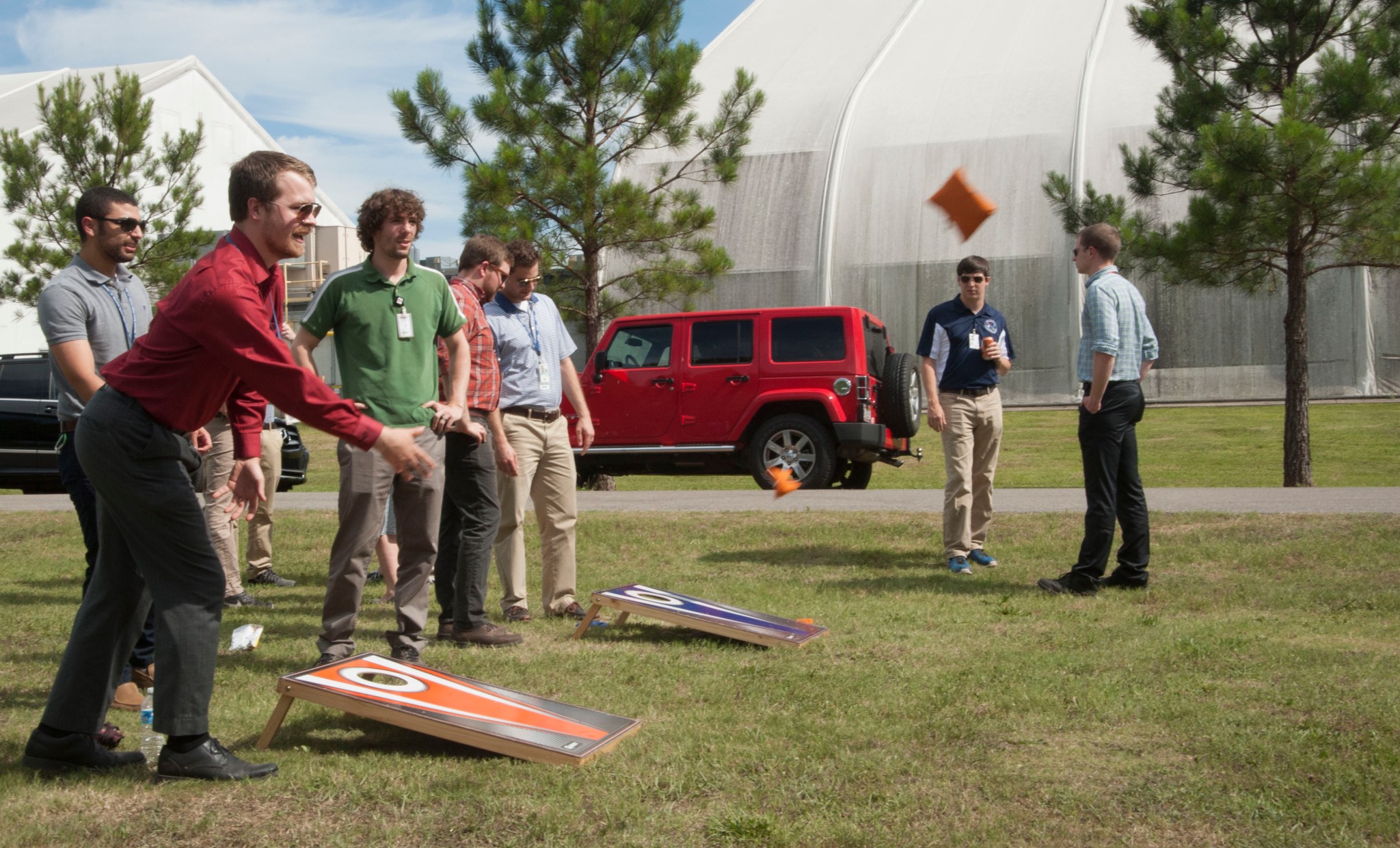
In addition to ice cream, Marshall team members enjoyed 1,000 burgers, 600 hot dogs, 60 veggie burgers, 500 orders of funnel cake fries and a mountain of shaved ice. Here, team members work off some calories enjoying one of the games at the Great Exchange Summer Blast on June 9. (NASA/MSFC/Krisdon Manecke)
This Week in NASA History: Sally Ride Becomes First American Woman in Space — June 18, 1983
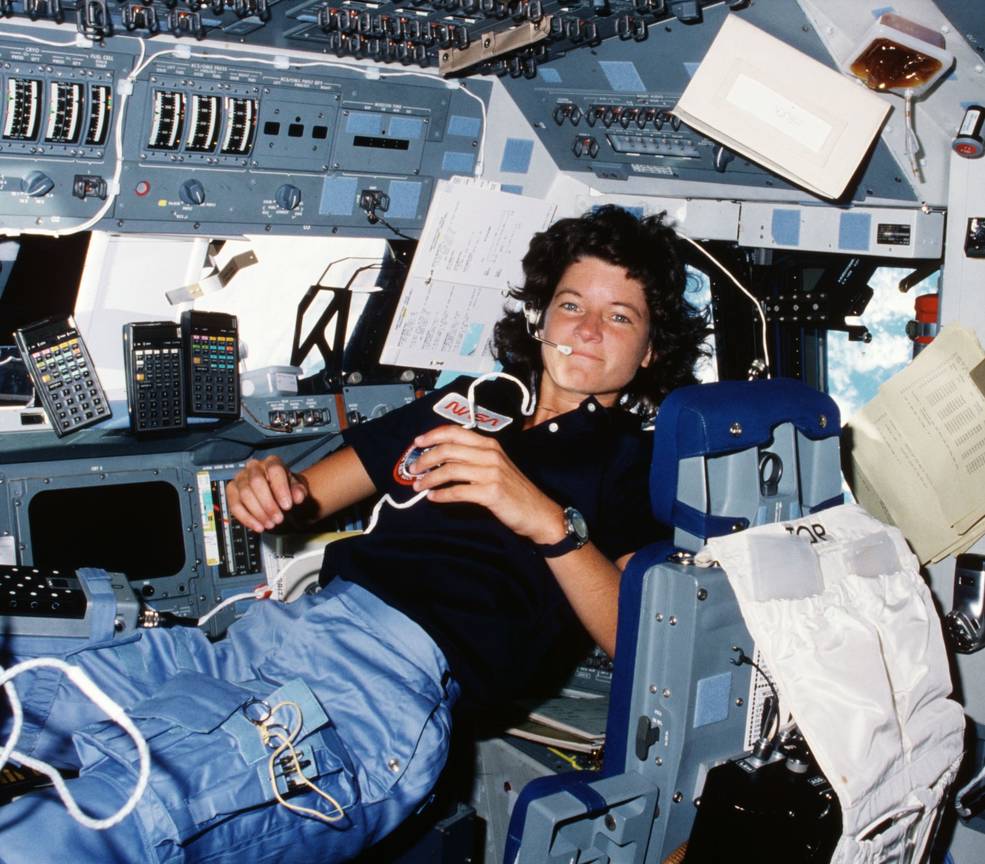
This week in 1983, space shuttle Challenger and the STS-7 crew launched from NASA’s Kennedy Space Center. With the launch, Mission Specialist Sally Ride became the first American woman to fly in space. The STS-7 crew, the first five-member crew, deployed two communications satellites and conducted experiments from the Shuttle Pallet Satellite. Ride, shown here floating in the Challenger flight deck, later described the launch as “exhilarating, terrifying and overwhelming all at the same time.” The NASA History Program is responsible for generating, disseminating, and preserving NASA’s remarkable history and providing a comprehensive understanding of the institutional, cultural, social, political, economic, technological, and scientific aspects of NASA’s activities in aeronautics and space. For more pictures like this one and to connect to NASA’s history, visit the History Program’s webpage. (NASA)
Obituaries
Davis A. Wilson, 74, of Huntsville, died May 6. He retired from the Marshall Center in 2001 as an aerospace engineer.
Donald E. Herda, 85, of Toney, Alabama, died May 29. He retired from the Marshall Center in 1999 as an aerospace engineer.
